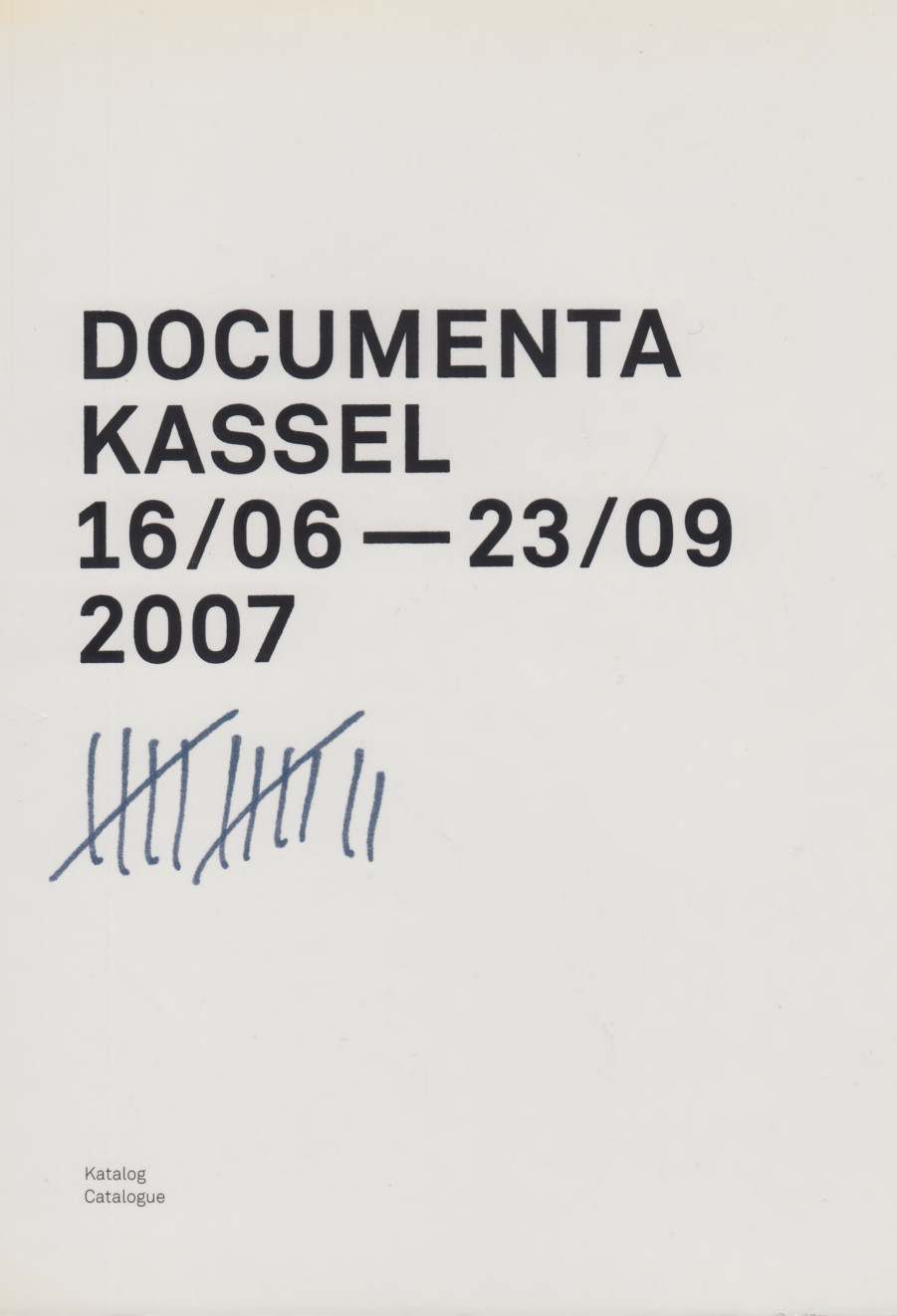documenta 12 (2007) [German/English]
Filed under catalogue | Tags: · art, contemporary art, form, migration

“For the first time in the history of the documenta, the major event in Kassel was organized under the direction of a couple: Roger M. Buergel as the designated art director and Ruth Noack as curator. They served only “unofficially” as a two-member directorial team, however, as the documenta statutes do not allow for the possibility of two co-directors. Together, they developed a clearly defined programmatic concept under the banner of “The Migration of Forms.” What that meant was that, over the course of human history, visual culture has had only a limited number of basic forms with which to work—forms that have been used in different contexts and with different conceptual focuses throughout the history of art. Buergel/Noack pointed out that “contemporary does not mean that the works originated yesterday. They must be meaningful for people today. Documenta 12 is concerned with both historical lines of development in art and unexpected concurrences.” In order to bring these “unexpected concurrences” to light, relationships were established between works of art from different decades and cultures in which similar formal patterns have emerged—a process that has led to a “migration” of aesthetic forms across temporal and cultural boundaries culminating in the art of our postmodern world. This formalism was emphasized in the Neue Galerie by walls painted different colors. In turn, this focus on the phenomenon of migration resulted in the selection of a high percentage of artists from Africa, Asia, and Eastern Europe. New to the program was the inclusion of old art, from fourteenthcentury Persian miniatures to global art from recent decades. Artists already long since recognized in their own homelands, such as Nasreen Mohamedi, for example, were not the only ones presented to a broad public in Germany for the first time. The works of several exemplary artists—John McCracken, Kerry James Marshall, Charlotte Poseneske, and Gerwald Rockenschaub—also migrated through all exhibition venues.” (Source)
Publisher Taschen, Cologne, 2007
ISBN 9783836500524, 3836500523
415 pages
via x
PDF (148 MB, no OCR)
Comment (0)Saltwater: A Theory of Thought Forms (2015) [English/Turkish]
Filed under catalogue | Tags: · art, city, contemporary art, form, istanbul, science, theory

Catalogue for the 14th Istanbul Biennial, held 5 September – 1 November 2015 and curated by Carolyn Christov-Bakargiev.
“Saltwater: A Theory of Thought Forms hovers around a material – salt water – and the contrasting image-forms of knots and waves. It looks for where to draw the line, to withdraw, to draw upon, and to draw out. It does so offshore, on the flat surfaces with our fingertips, but also in the depths, underwater, before the enfolded encoding unfolds.
This city-wide exhibition on the Bosphorus considers different frequencies and patterns of waves, the currents and densities of water both visible and invisible that poetically and politically shape and transform the world. With and through art, we mourn, commemorate, denounce, try to heal, and we commit ourselves to the possibility of joy and vitality, of many communities that have co-inhabited these spaces, leaping from form to flourishing life.”
With essays by Emin Özsoy, Aurora Scotti, Jean-Michel Vappereau, Griselda Pollock, Pietro Rigolo, Beatriz Colomina, Boris Groys, Alexander Provan, Andrew Yang, Vilayanur S. Ramachandran, Elvan Zabunyan, Penelope Deutscher, Adrian Parr, Bracha L. Ettinger, William Irvine, Chus Martínez, Jeffrey Peakall, Orhan Pamuk, and an anthology edited by Ingo Niermann.
Drafted by Carolyn Christov-Bakargiev
Edited by Süreyyya Evren
Publisher Istanbul Foundation for Culture and Arts and Yapı Kredi Publications, Istanbul, 2015
Open access
ISBN 9786055275259, 6055275252
lxii+540 pages
Henri Lefebvre: Right to the City (1968–) [FR, ES, EN, BR-PT]
Filed under book | Tags: · city, form, industry, marxism, philosophy, theory, urbanism, utopia

Lefebvre’s highly polemical book on the city was completed in 1967 to commemorate the centenary of the publication of Marx’s Das Kapital, and came out before the events of 1968.
David Harvey wrote about its central thesis: “The right to the city is far more than the individual liberty to access urban resources: it is a right to change ourselves by changing the city. It is, moreover, a common rather than an individual right since this transformation inevitably depends upon the exercise of a collective power to reshape the processes of urbanization. The freedom to make and remake our cities and ourselves is … one of the most precious yet most neglected of our human rights.” (Source)
First published in book form as Le droit à la ville, Anthropos, Paris, 1968.
English edition
Translated and Introduced by Eleonore Kofman and Elizabeth Lebas
Chapter in Writings on Cities
Publisher Blackwell, 1996
ISBN 0631191879
pages 61-181
Wikipedia (EN)
Commentary: Notbored.org (2006).
Le droit à la ville (French, one chapter only, 1967)
El derecho a la ciudad (Spanish, trans. J. Gonzalez-Pueyo, 4th ed., 1969/1978, 38 MB)
Right to the City, in Writings on Cities (English, trans. Eleonore Kofman and Elizabeth Lebas, 1996, ARG)
O direito à cidade (Brazilian Portuguese, trans. Rubens Eduardo Frias, 5th ed., 2001/2008, 5 MB)
For more from Lefebvre see Monoskop wiki.
Comment (0)
